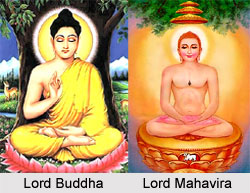 The revolution of 6th century B.C. gave rise to different religions and religious sects. This period witnessed the birth of several saints who revolutionized the religious world. Lord Buddha and lord Mahavira were the most famous and important among these saints. Purna Kashyapa, Mantkhai Ghosal, Ajati Kambali, Prakadhu Katyayam, Sajayer Vaelishta Puttra, Nirganth Gyat Puttra or lord Mahavira are six religious leaders who find mention in the Buddhist texts. Both Buddha and Mahavira severely criticized Brahmans religion and opposed yajans and sacrifices. They preached people to break the bonds of caste system and sectarianism as well. They laid stress upon the self-discipline, right conduct, right action, good character etc. However, the ideas contained in Buddhism and Jainism are not original and seem to be obviously influenced by the Upanishads. Sri B.G. Gokhale has rightly remarked, "In the 6th century, B.C. when some major Upanishads were being compiled, is rightly described as an age of intellectual ferment, the atmosphere was full of doubts and the mind of the men in India rocked by revolutionary ideas."
The revolution of 6th century B.C. gave rise to different religions and religious sects. This period witnessed the birth of several saints who revolutionized the religious world. Lord Buddha and lord Mahavira were the most famous and important among these saints. Purna Kashyapa, Mantkhai Ghosal, Ajati Kambali, Prakadhu Katyayam, Sajayer Vaelishta Puttra, Nirganth Gyat Puttra or lord Mahavira are six religious leaders who find mention in the Buddhist texts. Both Buddha and Mahavira severely criticized Brahmans religion and opposed yajans and sacrifices. They preached people to break the bonds of caste system and sectarianism as well. They laid stress upon the self-discipline, right conduct, right action, good character etc. However, the ideas contained in Buddhism and Jainism are not original and seem to be obviously influenced by the Upanishads. Sri B.G. Gokhale has rightly remarked, "In the 6th century, B.C. when some major Upanishads were being compiled, is rightly described as an age of intellectual ferment, the atmosphere was full of doubts and the mind of the men in India rocked by revolutionary ideas."



















